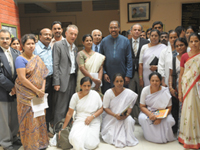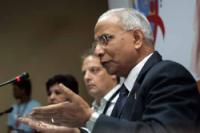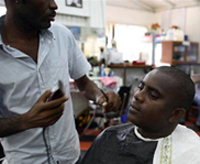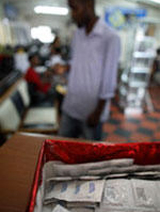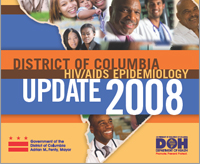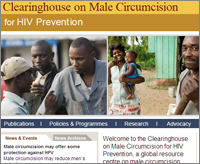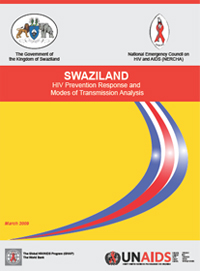
Cover of Swaziland report.
Credit: UNAIDS
If national HIV prevention strategies are to succeed, countries must understand the character and drivers of their epidemic and focus on proven need through sustained and effective interventions. However, there is often a mismatch between HIV prevention efforts and the actual factors driving new infections. This can lead to significant resources being invested in programmes of limited effect which do not reach those most at risk. To address this situation in five African countries, National AIDS Authorities, UNAIDS and the World Bank have produced a series of detailed reports that aim to characterize the true nature of the respective epidemics and their drivers, the existing HIV prevention response and the allocation of funding for prevention.
The leadership demonstrated by the countries that have undertaken this analytic work is a first and important step towards building effective prevention strategies
Mark Stirling, Director of UNAIDS Regional Support Team for Eastern and Southern Africa.
Drawing on new and existing data, final synthesis reports from Kenya, Lesotho, Swaziland and Uganda look at the expected distribution of new infections over the next 12 months. (Mozambique, the fifth country, will release its study soon and Zambia is also preparing a report). On the basis of all the data, the reports assess the alignment between this evidence and the HIV policies and interventions in the countries. The four reports then offer recommendations to improve national HIV prevention strategies. Already, they have begun to feed into existing national planning and policy deliberations, in some countries going as far as informing development and review of prevention strategies and policy guidance.
“AIDS continues to undermine every effort and investment towards human development in this region. Countries, therefore, cannot afford to ignore the pressing need to review national HIV prevention strategies to ensure greater efficacy,” said Mark Stirling, Director of UNAIDS Regional Support Team for Eastern and Southern Africa. He added, “The leadership demonstrated by the countries that have undertaken this analytic work is a first and important step towards building effective prevention strategies.”
The studies give very specific illustrations of challenges emerging from the relative lack of evidence-based policies and programmes, while acknowledging that all of the countries have made considerable progress in addressing HIV and that several have seen their epidemics stabilize.
In Lesotho, for example, which has the third highest adult prevalence in the world, the study shows that there is an “exceptionally high” number of multiple and concurrent sexual partnerships before and during marriage. The bulk of new infections in 2008 were likely to occur in those reporting a single-partner (35-62%) and people in multiple partnerships. Yet, according to the report, national prevention strategies do not explicitly address concurrent partnerships and no activities are designed specifically for adults, married couples and people in long-term steady relationships.
The Kenya report describes a mixed epidemic that varies considerably across the country, requiring interventions planned and implemented at local level. However, strategies were found to be “general and overarching” and not specifically aimed at most-at-risk populations, which include those in certain mobile occupations such as the fishing community and truck drivers. Even where the evidence shows a clear need for it, Government funding aimed at other most-at-risk groups, such as sex workers, their clients, men who have sex with men and injecting drug users is “negligible or non-existent”.
It emerges, therefore, that across the countries significant resources are invested in a range of prevention interventions that are not rigorously evaluated for their “impact or quality” and, for some, spending on prevention is considered simply too low. (Spending in this area varied from 13% of the national AIDS budget in Lesotho where adult HIV prevalence is 23.2%, to 34% of the AIDS budget in Uganda with adult prevalence of 5.4%).
According to Debrework Zewdie, Director of the World Bank’s Global HIV/AIDS Unit, "The current global economic situation has made it more important than ever to get the most impact possible from our investments in HIV prevention. These syntheses use the growing amounts of data and information available to better understand each country's epidemic and response, and identify how prevention might be more effective. They are guiding the programmes we support."
The reports give concrete recommendations on how to move towards a more efficient use of resources through more evidence-informed prevention strategies. For example, Uganda recommended the establishment of clear policies, standards and guidelines to improve counseling and testing services, IEC and behaviour change interventions for married and long-term sexual partners, people living with HIV and at risk groups. Swaziland also recommended that married, cohabiting and steady couples be acknowledged as a priority population and, further, that stronger political leadership for HIV prevention be exercised in order to build widespread engagement to address the complex norms underlying the level of vulnerability to infection in the country.
The National AIDS Authorities and the UNAIDS and World Bank teams who have produced these wide-ranging and rigorously researched reports see them as an initial round of synthesis work which will form part of ongoing AIDS-related evaluations aimed at strengthening and sharpening national responses to the epidemic.
Note: The Analysis of Prevention Response and Modes of Transmission Study series is part of a programme of work led by National AIDS Authorities and UNAIDS Country Office teams with support from the UNAIDS Regional Support Team for Eastern and Southern Africa, UNAIDS Geneva and the World Bank's Global HIV/AIDS Programme.





